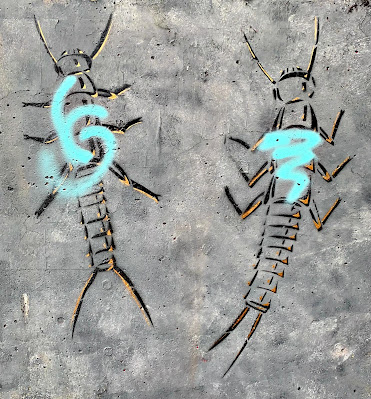1954: Onset of Arthropocene: the urgent exoskeletal sibling to Anthropocene with its burgeoning vertebrate legions.
Now, we’ve arrived at the swarming convergence of three (un)realities.
One vector: the recent and continuing, alarming news about the demise of multiple arthropod species, notably Insects and Crustaceans.
Second factor: Our hyper-awareness of Arthropods appearing in our town — as we stroll, as we dine, as we gaze, Yes, They return our gaze, with quickening desire, with appetite.
Third: the metamorphosing metaphor spawned by 1950s “horror” films; stark emergence of mutant arthropodal creatures — motivated, invasive, irradiated.
Wait. A cautionary dimension: Street Art. Illustrated herein with a variety of painterly arthropods in various stages of infestation. The streets, the art in 21st century Eugene, Oregon.
Photos Douglas Beauchamp. All rights preserved in amber.
These public paintings may be officially authorized decorations, condoned community expressions, or simply hatch out of nowhere. Fleeting images — realer-than-real, glowing, inverted, eradicated. Do not make the mistake of thinking that what happens on walls is purely imaginative.
NOTES
Arthropocene and its cultural milieu merged from and during the Atomic Era:
— 1954: Them! The first feature film to use insects — irradiated ants become monsters with a final battle in the concreted Los Angeles River drainage.
— 1955: In nearby Orange County, Disneyland opens launching Adventureland —an exotic tropical place dreaming to be a far-off region of the world — "To create a land that would make this dream reality” — Walt Disney.
— 1957: Further… Beginning of the End — radiation used to grow giant vegetables is eaten by locusts, who naturally enlarge and become understandably voracious and… the title says it. Attack of the Crab Monsters — Pacific Ocean, a Disney-like tropical island where atomic tests alter plants and animals among them an intelligent and ambitious Crustacean confronting innocent scientists.
— Honorable mentions: The Wasp Woman (1960), a hybrid femme fatale. Mothra (1961), the breakout franchise who doesn’t know how to stop.
— The List goes on and on… leading to… ARTHROPOCENE (2022) with its countless waterway invasives, airborne exotics, and vectoring tropical stingers.
END CREDITS
After diligent online searching, I have found only two instances of Arthropocene used in the eco-environmental sense I have exposed and expoused:
— Arthropocene:Coleoptera:Ips Typografus — a six-minute experimental film (2020) about “the relation we are developing with arthropods in the edge of a climate crisis." In this case, the Ips Typografus beetle. The artists Augusto Gerardi and Estefania Montero note, since 2018 all the forests in Europe are at risk because the outburst of this beetle. (Recommended)
— The Arthropocene: An Introduction to Invertebrates Informing Ecosystem Health and Ecological Restoration in Freshkills Park, SI (2021). An Honors Thesis by Audrey Becker (PDF)












